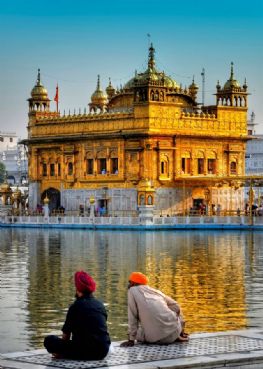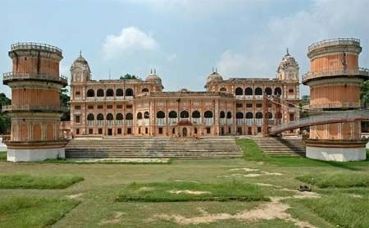Tour Amritsar in Punjab
The city of Amritsar in Punjab is a beautiful blend of tradition, culture, history and food.
The city of Amritsar in Punjab is a beautiful blend of tradition, culture, history and food.
Founded in 1577 by the fourth Sikh guru, Ram Das, the city is divided into two parts by the railway lines.
In the old city to the south you will find the famous Golden Temple, one of the most spectacular and visited places in India, along with many other ancient historical attractions.
The Golden Temple is the pride and soul of the Sikhs and is a center of attraction between Indians and foreign travelers for centuries.
The golden body, the mystical lake and the atmosphere that reigns make this religious site a unique and unrepeatable place. Believers, regardless of their religion, caste and sex crowd Amritsar in search of eternal bliss and are amazed by seeing the humble nature and the deep convictions of the Sikhs towards their religion.
The north side of the city consists of exclusive restaurants, sparkling towers, modern houses and other bright signs of the city's contemporary prosperity.
Attractions in Amritsar
Golden Temple
The beautiful Golden Temple is actually only a small part of this huge gurdwara complex, known to the Sikhs as Harmandir Sahib.
Spiritually, the center of attention is the tank that surrounds the bright central sanctuary - the Amrit Sarovar, from which Amritsar takes its name, excavated by the fourth Sikh guru, Ram Das, in 1577.
The Golden Temple is a fascinating blend of Hindu and Islamic architectural styles, with an elegant lower marble level adorned with floral motifs and hard stone animals (as seen on the Taj Mahal). Above this stands a shimmering second level, encased in intricate and etched gold panels, and surmounted by a golden dome with 750 kg of gold.
Inside the splendid sancta sanctorum, priests and musicians constantly sing from the Sikh sacred book, adding a lot of charm to the already very intense atmosphere.
Other shrines and monuments are scattered around the temple of gold including the clock tower of the main entrance, the Sikh Museum which shows the persecution suffered by the Sikhs in the hands of Mughals, British and Indira Gandhi.
At the south-east end is the Ramgarhia Bunga, a protective fortress surmounted by two Islamic-style minarets; inside it is a stone slab once used for the Mughal coronations, but which was conquered by Delhi by the Sikh forces in 1783.
Wagah Border
Wagah is about 29 km from Amritsar in Punjab province.
Wagah is the border on the grand trunk road that marks the dividing line between Pakistan and India.
On this border, a retreat ceremony called 'lowering of the flags' has been held every single evening since 1959.
The ceremony has gained a huge following, and is witnessed by hundreds of people every day on both sides of the border.
The Retreat ceremony starts 30 minutes before sunset. As a prelude, public address systems on both sides play their most impassioned patriotic songs.
The Border Security Force (BSF) jawans encourage women and children to hold the national flag, sprint towards the gates, and dance to Bollywood tracks in celebration. The positivity of this environment might surprise people who would expect hostility or tension between India and Pakistan, but this ceremony is consistently an expression of joy, fun and love for one’s country, without hating the other. The pageantry and the pomp attracts a large gathering and makes for a great spectacle.
Tarn Taran
Located at 22 km from the Golden Temple, Tarn Taran is a Sikh pilgrimage site in the Tarn Taran District of Punjab.
It is believed that the Sarovar located in this Gurudwara is the largest among all the Sikh Shrines. Tarn Taran is counted among the most popular Sikh pilgrimage sites in India and thronged by the devotees every month on the day of Amavas.
Mata Temple
Credited with fertility-improving powers, this fascinating labyrinthine Hindu temple commemorates the 20th-century female saint Lal Devi. From the main hall, a narrow series of stairways and passages winds past mirrored mosaics, fairground-style carvings and untold deity statues to a semi-submerged mock-up of the Vasihno Devi cave temple.
Durgiana Temple
Durgiana is located an half kilometre from the Golden Temple and looks like a replica of the same.
Dedicated to Goddess Durga, the temple was built in 1908 by Harsai Mal Kapoor.
The temple complex encloses the seats of Lord Hanuman, Mata Shitla, along with Lakshmi Narain.
Akal Takht
It is a Sikh temple built at the premise of the Golden Temple by Guru Hargobind Sahib as a place of justice and for resolving temporal issues. It is considered to be the highest seat of earthly authority of Khalsa. The literal meaning of Akal Takht is throne of the timeless one and it is a symbolic representation of the political sovereignty of the Sikhs.
Jallianwala Bagh
Jallianwala Bagh is the site of one of the most monstrous massacres in human history and a dark event during the Indian struggle for independence.
About a mile from the Golden Temple, Jalianwala Bagh is a memorial that commemorates the atrocious massacre done by the British army on April 13, 1919, which was Punjabi's New Year. On that auspicious day for the punjabi the British occupation forces brutally opened fire on a peaceful mass and about 379 people were killed and about 1100 people were wounded.
In 1951 a memorial was established on this land to commemorate the massacre. An enormous commemorative stone is located at Jalianwala Bagh.
Ram Tirath
Ram Tirath is an ancient pilgrimage center associated with the period of Ramayana, located about 11 km west of Amritsar city. This is said to be the place where Lord Ram and Sita’s twins, Luv and Kush, were born. Sage Valmiki is believed to have scripted the epic Ramayana at Ram Tirath, as well; visitors will still find Valmiki’s old hut here.
Central Sikh Museum
Central Sikh Museum preserves the gruesome history of the Sikhs’ martyrdom at the hands of the Mughals, the British, and Operation Bluestar. Established in 1958, the gallery now hosts a collection of portraits of Sikh gurus, saints, warriors and prominent leaders. Visitors will also find a rich collection of coins, arms, and ancient manuscripts, as well as an excellent library.
Foto Gallery
Our tours in Amritsar (Punjab)
We have other organized tours to visit Amritsar.If you don't find a tour that satisfies you needs, we can organize one only for you!
 ITA
ITA DEU
DEU FRE
FRE SPA
SPA















